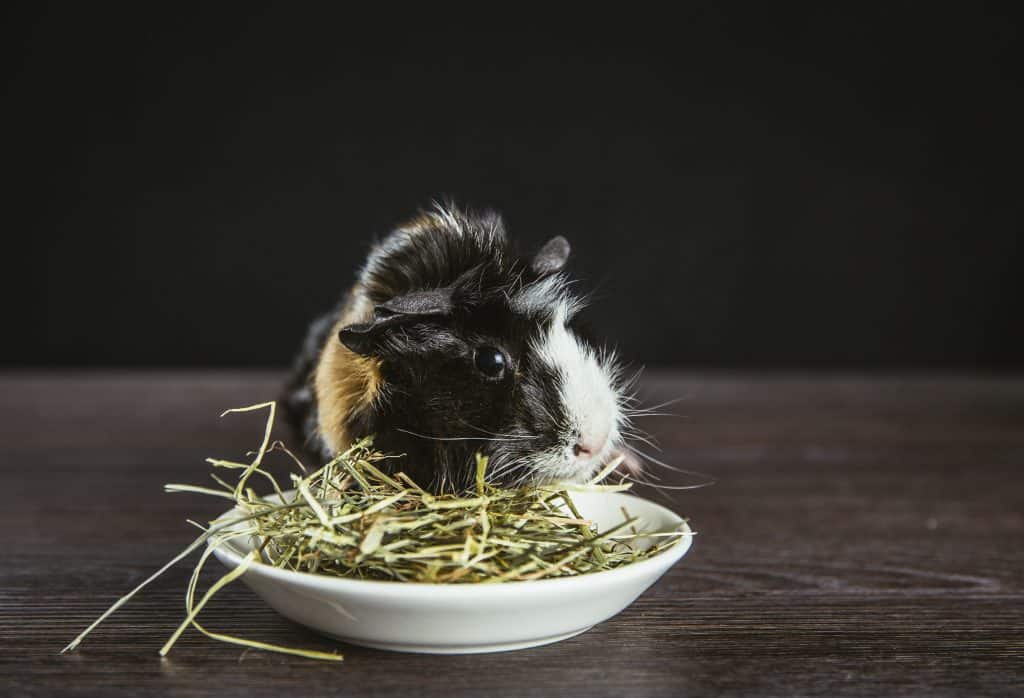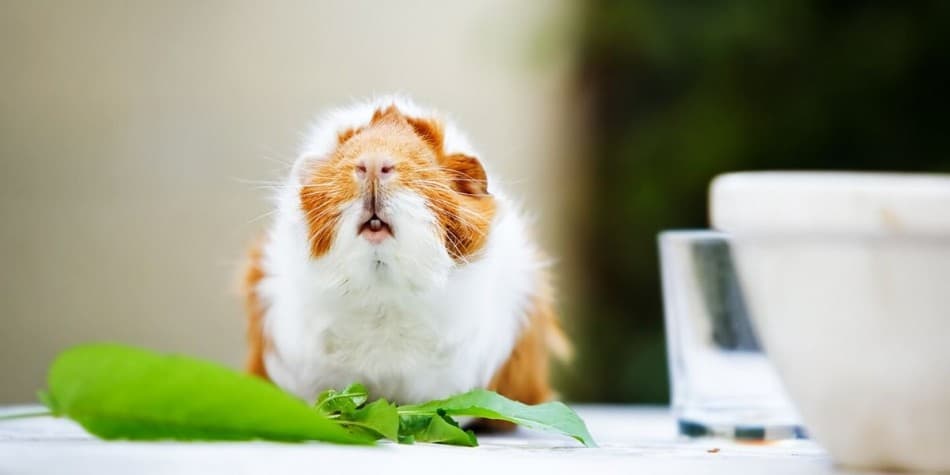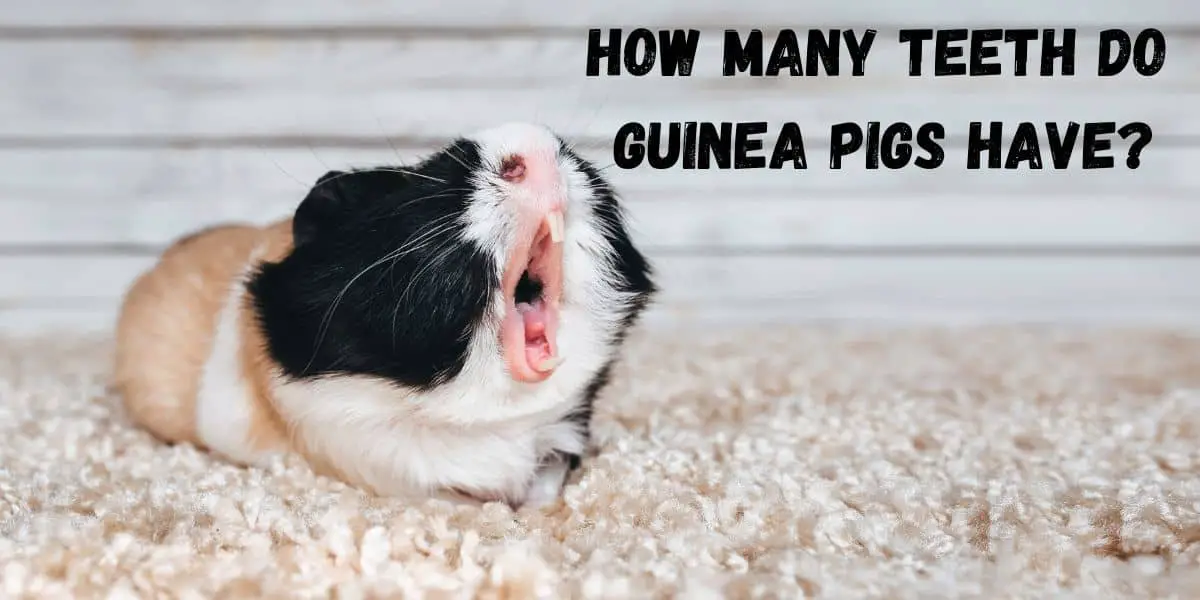Part of being a responsible pet owner is to care for all aspects of your pet’s health and welfare. Dental care for Guinea pigs is one area you’ll need to keep a close eye on to avoid illness and large vet bills.
Many new Guinea pig owners are unaware of the responsibility and care they’ll need to show for their Guinea Pigs teeth.
Have you ever wondered, how many teeth do guinea pigs have?
Adult Guinea pigs have twenty teeth in total. Guinea pig teeth will also always continue to grow throughout their life. There are some health issues that can develop if this is not kept in check. Correct dental care for guinea pigs is vital.
This in mind, there are some signs you will want to keep an eye out for. There are also some things you can do to protect your guinea pig’s teeth -all 20 of them!

How Long Should My Guinea Pig’s Teeth Be?
So, how many teeth do guinea pigs have? Twenty… but you can only see four. These are their incisors, two upper, and two lower. As obligate herbivores (plant-eaters only), guinea pigs do not have any canines to speak of.
Rather, their incisors are just sharp enough to gnaw through wood, make quick work of crunchy produce, etc. The rest of their teeth are in the cheeks and back of the mouth and can be difficult to view.
Your guinea pig’s teeth should be between ⅓ an inch and just over ½ an inch long. They should meet neatly, without a gap or overlap. This is something you will need to keep an eye on, as guinea pig teeth always grow!
Incorrect growth, and the myriad of issues it causes, can be a risk. Along with monitoring your guinea pig’s teeth, there are some effective ways that you can help them keep excessive growth in check.
Guinea Pigs Need Plenty of Hay To Chew
As you probably know, guinea pigs eat hay above all. This grass-like plant is the perfect balance of high fiber and low-cal. The stiff surface also gives guinea pigs something to really sink their teeth into; something to chew. Believe it or not, guinea pigs whittle their teeth down when they chew.
For this reason, your guinea pig should always have access to hay. Your best bet is Timothy Hay, as this is the highest fiber and the most low-cal. Alfalfa hay is higher in calories, calcium, and protein, and so this is a variety you will want to monitor. The same can be said of clover.
This being said, for their prime dental health, your guinea pig will need more than just hay to chew!

Some of the best Hay you can provide for your Guinea Pig is Timothy Hay which we purchase directly from Amazon. Here’s the link!
Pellets
How many teeth do guinea pigs have? Help them keep all twenty, by feeding them right! Along with hay, we suggest you give your guinea pig some pellets as well. These are full of fiber, as well as specially-fortified with precious vitamins like vitamin C.
Pellets are also rather hard and crunchy, and as a result, excellent for guinea pigs to chew. Just make sure to pick quality pellets, rather than a cheap kind full of filler.
We really like ‘ Small Pet Pellets ‘ available on Amazon. The vitamins and minerals contained within this product are correctly balanced and provide a good staple diet for your Guinea Pig.
Crunchy Fruits and Veggies
How many teeth go guinea pigs have? Twenty, when their teeth are healthy. Keep each of your guinea pig’s teeth in tip-top shape, by giving them plenty to chew. To this end, crunchy fruits and veggies can make a perfect treat or snack.
Of course, not all fruits and vegetables are guinea pig-safe. Some are downright poisonous (like garlic, onion, avocado, potato, etc.). Ingesting these can prove fatal. So use care.
Some great, super crunchy and tooth-healthy fruits and veggies for your guinea pig are carrots, apples, cucumbers, Brussel sprouts, and more.
Malocclusion
Should your guinea pigs’ teeth become too long or crooked, malocclusion becomes a serious risk. This is where your guinea pig will experience a misalignment of their teeth and jaw. As you can imagine, this can be quite uncomfortable.
At its worst, their roots may begin to grow back into their jaw. Without prompt, proper treatment, this can prove fatal. Maloccluded teeth will cause mouth sores, infections, and more.
Signs of malocclusion in guinea pigs are:
- Eye and/or nose discharge
- Weight loss and/or anorexia (it will simply hurt or be impossible for them to eat!)
- They will have their mouth perpetually open (to relieve the pressure in their jaw)
- Drool around the mouth and chin
- Chewing one side of the mouth (their teeth may not be aligned properly)
- Dropping pieces of food (they may be having trouble biting the food and may not be able to chew)
- Picking up food and then dropping it (they are hungry, but can’t eat without discomfort)
If you believe your guinea pig has developed malocclusion, take them to a professional.
Broken Teeth
Did you know that guinea pigs have white teeth, whereas most animal teeth (including hamsters and rabbits) are rather yellow! If your guinea pig has yellow teeth, more likely than not, they are lacking in vitamin C.
Vitamin C deficiency is one of the main things that will cause guinea pig teeth to break. When we wonder, how many teeth do guinea pigs have, remember that to keep all twenty, they will need lots of vitamin C!
Vitamin C is essential in order for bones and teeth to grow. Because they do not produce vitamin C of their own, guinea pigs are especially at risk. Keep an eye out in case any of your guinea pig’s teeth break. Provide them with plenty of vitamin C to avoid this risk.

Great Sources of Vitamin C
Fruits and veggies are fantastic sources of vitamin C. Take a look at some guinea pig-safe fruits and veggies that are chock-full of vitamin C, below!
| 1 medium red bell pepper | 152mg |
| 1 small orange | 51mg |
| 1 medium strawberry (include the leaves) | 7.1mg |
| 1 medium tomato (do not include the leaves) | 14mg |
Bell Pepper
Each day, your guinea pig may enjoy 1-2 TBSP of bell pepper. As it turns out, this spicy-sweet vegetable is a wonderful source of vitamin C.
Red and orange bell peppers contain the most, but green bell peppers have lots of vitamin C as well. Feel free to offer some of each kind, for varied nutrients and flavor.
Orange
Your guinea pig can have some orange and the peel! This is a juicy and refreshing fruit that guinea pigs tend to savor. Oranges are packed with vitamin C and a perfect way to hydrate your guinea pig in the summer. You can give your guinea pig a slice or two of orange, up to two times a week.
Tomato
Tomatoes are rich in vitamin C, and vitamin K. Both nutrients are key when it comes to healthy bone development. Your guinea pig can have 1 cherry tomato a day, or the equivalent, 5-6 times a week.
Strawberry
Like most berries, strawberries contain generous amounts of vitamin C. These tend to have a bit more than most, however. When it comes to providing your guinea pig with vitamin C, strawberries are ideal. Just be sure to portion with care, as strawberries contain a lot of sugar. Try a tiny strawberry or half a medium-large strawberry, twice a week.
Do Guinea Pig’s Grow Teeth Back?
How many teeth do guinea pigs have? Does yours have less than the usual twenty? You may want to know if your guinea pig’s teeth will grow back. As a matter of fact, guinea pig’s teeth do grow back!
However, the process of tooth loss can be distressing and painful. Try to avoid this, if you can. Sometimes it is inevitable, however.

Other Things Your Guinea Pig Can Chew
Along with food, you can give your guinea pig wood to chew. This will go a long way toward helping them keep their teeth in check. Avoid potentially toxic woods, like pine and cedar. Instead, get them toys, blocks, or sticks made from aspen, hickory, maple, or oak!
Final Thoughts
Always keep an eye out in case malocclusion of any sort begins to occur. Or, if a tooth happens to break. Make sure that your guinea pig has enough vitamin C, and plenty of nutritious, crunchy food, and wood to chew! Keep your guinea pig’s teeth healthy, and when you wonder, how many teeth do guinea pigs have? You will know.






